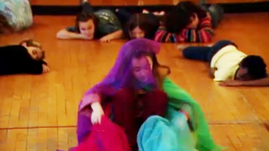Teachers' Domain - Digital Media for the Classroom and Professional Development
User: Preview


In this video segment for teachers, Dr. Marianne McAdam, director of the dance minor program at Eastern Kentucky University, shows an example of integrating creative dance with another subject area. She guides a group of fourth grade students from EKU’s Model Lab School in creating a dance based on the book The Loon Spirit, a Native American story. As they explore the dance element of force, they are also reinforcing their reading comprehension and understanding of the story.
Find additional arts resources for your classroom at the KET Arts Toolkit website.
Children are naturally active, and movement is one of the eight multiple intelligences identified by Howard Gardner. Dance is an excellent way for students to learn, and express what they have learned, in other subject areas. Math, spelling, history, science, and literature are all well suited for integrating with dance. Dance is a way for students to express ideas, and it also encompasses problem-solving, cooperation, and collaboration—some of the important 21st Century Skills we want our students to have. In fact, children who may not be successful in a standard academic setting often excel with creative dance activities.
A creative dance lesson consists of three main parts: exploring the concept, creating a dance based on exploration, and reflecting on the dance produced. Not comfortable with your own dancing skills? Don’t worry. The creative dance instructor does not dance with the children, so you do not have to be a dancer. Instead, your role is to guide your students into exploring all the ideas of a particular idea or element of dance. Notice how the instructor in the video asks guiding questions to prompt student movement exploration.
This particular lesson is focused on force, the element of dance related to movement energy (sharp/smooth, heavy/light), and The Loon Spirit was well suited for this because the story includes several animal characters. The instructor also encourages students to vary their use of other elements, such as space (for example, they vary their movement levels to include moving high, low, and medium). The lesson begins with reading the story and brainstorming movement words that reflect students’ understanding of the animal characters and the story’s ideas. Notice that this is very different from having students pantomime or act out the story.
Creative dance can be used across grade levels with level-appropriate content. For example, at the middle or high school level students might interpret poetry through creative dance. They can explore themes and concepts in civics. How about a creative dance demonstrating how a bill becomes a law or the responsibilities of citizenship? Students could create a transportation dance, an immigration dance, or a supply and demand dance. At the same time they can be exploring the dance elements of space, time, and force—and expanding their problem-solving capabilities.
With younger and less experienced students, the final dance of the lesson is often a structured improvisation, as illustrated in the Dancing a Story video. As students get more experience, the final dance can involve more choreography, and its structure can become more complex, but the format remains the same. Identify a goal. Introduce the content and concepts. Allow exploration. Guide creation. And end with reflection by both dancers and their audience. The result can be an extraordinary way to learn.
 Loading Standards
Loading Standards